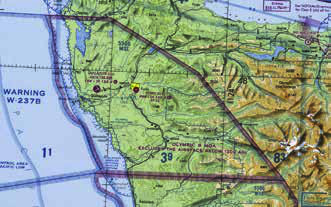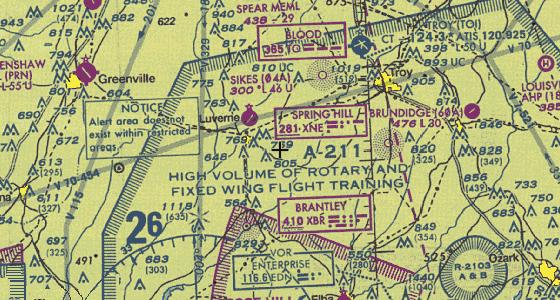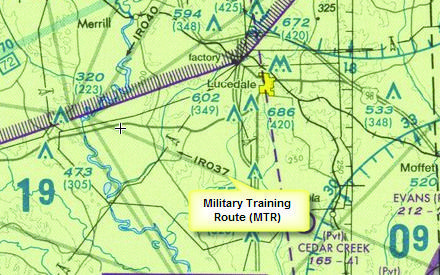Private Pilot
Helicopter Study Guide
Federal Aviation Regulations
§ 21.197 - Special Flight Permits
A special flight permit may be issued for an aircraft that may not currently meet applicable airworthiness requirements but is capable of safe flight, for the following purposes:
- Flying the aircraft to a base where repairs, alterations, or maintenance are to be performed, or to a point of storage.
- Delivering or exporting the aircraft.
- Production flight testing new production aircraft.
- Evacuating aircraft from areas of impending danger.
- Conducting customer demonstration flights in new production aircraft that have satisfactorily completed production flight tests.
SFAR 73 - R22/R44 Special Training
No person may manipulate the controls of an R22 or R44 without an endorsement of having received awareness training covering:
- Energy management
- Mast bumping
- Low rotor RPM (blade stall)
- Low G hazards
- Rotor RPM decay
No person may act as pilot in command of an R22 or R44 without either:
- at least 50 flight hours in that model and 200 flight hours total in helicopters
-
at least 10 hours dual instruction covering:
- Enhanced training in autorotation procedures
- Engine rotor RPM control without the use of the governor
- Low rotor RPM recognition and recovery
- Effects of low G maneuvers and proper recovery procedures
At least 20 hours of dual instruction is required before solo flight in an R22 or R44.
A flight review is only valid for an R22 or R44 if taken in that model and includes awareness training.
Currency requirements for carrying passengers in an R22 or R44 must be met in that model.
§ 61.3 - Requirement for Certificates, Ratings, and Authorizations
Required documents when acting as a required crewmember:
- Pilot Certificate
- Medical Certificate
- Government-issued photo ID
§ 61.5 - Certificates and Ratings
Pilot Certificates:
- Student pilot
- Sport pilot
- Recreational pilot
- Private pilot
- Commercial pilot
- Airline transport pilot
Aircraft Category Ratings:
- Airplane
- Rotorcraft
- Glider
- Lighter-than-air
- Powered-lift
- Powered parachute
- Weight-shift-control aircraft
Rotorcraft Class Ratings:
- Helicopter
- Gyroplane
§ 61.23 - Medical Certificates
- Private pilots must have at least a third-class medical certificate.
- A third-class medical certificate expires after 60 months for pilots under 40.
- A third-class medical certificate expires after 24 months for pilots 40 or older.
§ 61.35 - Knowledge Tests
Requirements:
- A photo ID with signature and date of birth
- An instructor endorsement
§ 61.39 - Practical Tests
Requirements:
- Passed the knowledge test within past 24 months
- Holds a third-class medical certificate
- At least 17 years old
-
An instructor endorsement indicating:
- Preparation for practical test
- Training within past 2 months
- Demonstration of knowledge of areas missed on knowledge test
§ 61.51 - Pilot Logbooks
Flights must be logged for:
- Experience used to satisfy requirements for a certificate
- Experience used to satisfy requirements for flight review
Logs must show:
- Date
- Total flight time
- Location
- Aircraft type and identification
- Type of training
- Day or night
-
For training:
- Description of training
- Legible endorsement from instructor
- Instructor certificate number and expiration date
On solo cross-country flights, students must carry:
- Logbook with endorsements
- Student certificate
§ 61.56 - Flight Review
Every 24 months, one of the following is required:
- Completion of a flight review with a logbook endorsement
- Completion of one or more phases of an FAA-sponsored pilot proficiency award program
A flight review consists of:
- 1 hour of flight training in any aircraft for which the pilot is rated
- 1 hour of ground training, including a review of FAR part 91
§ 61.57 - Recent Flight Experience
Requirements for carrying passengers:
-
Three takeoffs and three landings in the last 90 days:
- as sole manipulator of controls
- in an aircraft of the same category, class, and type
Requirements for carrying passengers at night:
-
Three takeoffs and three landings between 1 hour after sunset and 1 hour before sunrise in the last 90 days:
- as sole manipulator of controls
- in an aircraft of the same category, class, and type
§ 61.83 - Requirements For Student Pilots
An applicant must:
- Be at least 16 years of age for other than the operation of a glider or balloon.
- Be able to read, speak, write, and understand the English language.
§ 61.87 - Solo Requirements
Prior to conducting a solo flight, a student pilot must have:
-
Passed a knowledge test on:
- Applicable sections of parts 61 and 91
- Airspace where the solo flight will be performed
- Flight characteristics and limitations of the make and model of aircraft to be flown
- Received flight training for maneuvers and procedures
- Demonstration of proficiency and safety
- An instructor endorsement
§ 61.89 - Student Pilot Limitations
- No passengers
- No compensation
- No international flight, except in Alaska
- No flight with less than 3 SM visibility during the day or 5 SM at night
- No flight without visual reference to the surface
- No flight contrary to limitations placed by the instructor
§ 61.93 - Solo Cross-Country
Before making a solo cross-country flight, flight greater than 25 NM from the original airport, or landing at any other airport, a student must:- have received flight training appropriate to the make and model of aircraft
- have demonstrated cross-country proficiency on the appropriate maneuvers and procedures
- comply with any limitations in instructor endorsement
- have received training for the airport including flight in both directions over the route, entering and exiting the traffic pattern, and takeoffs and landings
- have a solo flight endorsement
- have an endorsement for the flight
§ 61.102 - Private Pilot Requirements
Applicants must:
- be at least 17 years of age
- be able to read, speak, write, and understand English
- receive a logbook endorsement from an instructor for the knowledge test
- pass the knowledge test
- meet the experience requirements
- pass a practical test
- hold a student pilot certificate
§ 61.113 - Private Pilot Privileges and Limitations
- No compensation
- No flight in connection with any business or employment unless the flight is only incidental
- No paying less than the pro rata share of operating expenses
- May act as pilot in command of a charitable event flight
- May be reimbursed for operating expenses directly related to sanctioned search and location operations
- May be reimbursed to demonstrate an aircraft to a prospective buyer if a salesman with at least 200 hours
§ 73.13 - Special Use Airspace Restrictions
No person may operate an aircraft within a restricted area between the designated altitudes and during the time of designation, unless he has the advance permission of the controlling agency.
§ 91.7 - Civil Aircraft Airworthiness
The pilot in command shall discontinue the flight when unairworthy mechanical, electrical, or structural conditions occur.
§ 91.9 - Civil Aircraft Flight Manual, Marking, and Placard Requirements
No person may operate an aircraft without:
- complying with the operating limitations specified in the Rotorcraft Flight Manual, markings, and placards
- a current Rotorcraft Flight Manual
- markings and placards
- aircraft identification
§ 91.17 - Alcohol and Drugs
No person may fly:
- Within 8 hours of consuming an alcoholic beverage
- With a BAC greater than or equal to 0.04
- With passengers who appear to be intoxicated except under medical care
§ 91.103 - Preflight Action
Each pilot in command shall, before beginning a flight, become familiar with all available information concerning that flight.
This information must include:
- weather reports and forecasts
- fuel requirements
- alternatives available if the planned flight cannot be completed
- runway lengths at airports of intended use
-
takeoff and landing distance information for:
- airport elevation and runway slope
- aircraft gross weight
- wind and temperature
§ 91.113 - Right-of-way Rules
An aircraft in distress has right-of-way over all other traffic.
When converging, the aircraft to the other's right has the right-of-way.
If aircraft are of different categories:
- Balloon
- Glider
- Airship
- Aircraft towing or refueling another aircraft
- All other engine driven aircraft
When approaching head-on, divert to the right.
Overtake well clear to the right. The aircraft being overtaken has right-of-way.
An aircraft on approach or landing has right of way. When two or more aircraft are landing, the aircraft at a lower altitude has right-of-way.
§ 91.119 - Minimum Safe Altitudes
For helicopters, an altitude which:
- prevents hazard to persons or property on the surface
- compiles with any routes or altitudes specifically prescribed for helicopters
§ 91.123 - ATC Compliance
In an emergency, notify ATC as soon as possible when deviating from a clearance or instruction.
If requested by ATC, a pilot must submit a detailed report regarding deviations from instructions within 48 hours.
§ 91.125 - ATC Light Signals
| Color and type of signal | Meaning on the surface | Meaning in flight |
|---|---|---|
| Steady green | Cleared for takeoff | Cleared to land |
| Flashing green | Cleared to taxi | Return for landing |
| Steady red | Stop | Give way to other aircraft and continue circling |
| Flashing red | Taxi clear of runway in use | Airport unsafe - do not land |
| Flashing white | Return to starting point on airport | Not applicable |
| Alternating red and green | Exercise extreme caution | Exercise extreme caution |
§ 91.137 - Temporary Flight Restrictions
Restrictions disseminated via NOTAM in order to:
- Protect persons or property
- Provide a safe environment for the operation of disaster relief aircraft
- Prevent unsafe congestion of sightseeing above an incident or event
See also AIM 3-5-3. Temporary Flight Restrictions.
§ 91.151 - Fuel Requirements
No person may begin a flight in a rotorcraft under VFR conditions unless there is enough fuel to fly to the first point of intended landing and to fly after that for at least 20 minutes.
§ 91.155 - Basic Weather Minimums
| Airspace | Flight visibility | Distance from clouds |
|---|---|---|
| Class B | 3 SM | Clear of Clouds |
| Class C | 3 SM | 500 feet below |
| 1,000 feet above | ||
| 2,000 feet horizontal | ||
| Class D | 3 SM | 500 feet below |
| 1,000 feet above | ||
| 2,000 feet horizontal | ||
| Class E: | ||
| Less than 10,000 feet MSL | 3 SM | 500 feet below |
| 1,000 feet above | ||
| 2,000 feet horizontal | ||
| At or above 10,000 feet MSL | 5 SM | 1,000 feet below |
| 1,000 feet above | ||
| 1 SM horizontal | ||
| Class G: | ||
| 1,200 feet or less above the surface (regardless of MSL altitude) | ||
| For helicopters: | ||
| Day | 1/2 SM | Clear of clouds |
| Night | 1 SM | Clear of clouds |
| More than 1,200 feet above the surface but less than 10,000 feet MSL | ||
| Day | 1 SM | 500 feet below |
| 1,000 feet above | ||
| 2,000 feet horizontal | ||
| Night | 3 SM | 500 feet below |
| 1,000 feet above | ||
| 2,000 feet horizontal | ||
| More than 1,200 feet above the surface and at or above 10,000 feet MSL | ||
| 5 SM | 1,000 feet below | |
| 1,000 feet above | ||
| 1 SM horizontal | ||
§ 91.203 - Aircraft Certifications
No person may operate a civil aircraft unless it has within it the following:
- An appropriate and current airworthiness certificate displayed at the cabin or cockpit entrance so that it is legible to passengers or crew
- An effective U.S. registration certificate issued to its owner
§ 91.205 - Required Instruments
Instruments required for day VFR:
- Airspeed indicator
- Altimeter
- Magnetic direction indicator
- Tachometer for each engine
- Oil pressure gauge for each engine using pressure system
- Oil temperature gauge for each air-cooled engine
- Fuel gauge indicating the quantity of fuel in each tank
- An approved safety belt for each occupant 2 years of age or older
- For rotorcraft manufactured after September 16, 1992, a shoulder harness for each seat
§ 91.207 - Emergency Locator Transmitters
ELTs must be inspected every 12 months.
Batteries must be replaced:
- after the transmitter has been in use for more than one cumulative hour
- after 50 percent of their useful life expires
§ 91.209 - Aircraft Lights
Position lights are required from sunset to sunrise.
§ 91.211 - Supplemental Oxygen
Between 12,500 feet MSL and 14,000 feet MSL, after 30 minutes, required flight crew must use supplemental oxygen.
Between 14,000 feet MSL and 15,000 feet MSL, required flight crew must use supplemental oxygen.
Above 15,000 feet MSL, each occupant must be provided with supplemental oxygen.
§ 91.215 - Transponders
A Mode C transponder is required:
- in Class B and Class C
- within 30 NM of Class B
- above the ceiling and within the lateral boundaries of Class B and Class C
§ 91.227 - ADS-B
After January 1, 2020, ADS-B out will be required:
- in Class B and Class C
- within 30 NM of Class B
- above the ceiling and within the lateral boundaries of Class B and Class C
- in Class E above 10,000 feet MSL and above 2,500 feet AGL
After January 1, 2020, if an aircraft is equipped with ADS-B out, it must be in transmit mode at all times.
§ 91.407 - Maintenance
No person may fly an aircraft that has undergone maintenance unless:
- It has been approved for return to service
- An entry has been made in the maintence records
No person may carry passengers in an aircraft that has undergone maintenance that may have appreciably changed its flight characteristics or substantially affected its operation in flight unless a pilot with at least a private pilot certificate flies the aircraft.
§ 91.409 - Inspections
An aircraft inspection is required:
- Every 12 calendar months
- Every 100 hours if operated for hire or used for flight instruction
§ 91.411 - Altimeter Inspections
Altimeters and automatic pressure altitude reporting systems must be inspected every 24 calendar months.
§ 91.413 - ATC Transponder Tests and Inspections
Transponders must be inspected every 24 calendar months.
Aeronautical Information Manual
AIM 1-1-4. VOR Receiver Check
VOR should read 0° FROM when tuned to a VOR test facility.AIM 1-1-17. Global Positioning System (GPS)
GPS consists of 24 satellites operated by the Department of Defense.
- Designed to ensure at least five satellites are always visible worldwide.
- At least four satellites are required to establish an accurate position.
RAIM is the capability of a GPS receiver to perform integrity monitoring on itself by ensuring available satellite signals meet the integrity requirements for a given phase of flight. Without RAIM, the pilot has no assurance of the GPS position integrity.
AIM 2-1-9. Pilot Control of Airport Lighting
Radio control of lighting is often provided at airports without control towers.
| Key Mike | Function |
|---|---|
| 7 times within 5 seconds | Highest intensity available |
| 5 times within 5 seconds | Medium or lower intensity |
| 3 times within 5 seconds | Lowest intensity available |
AIM 2-1-10. Airport/Heliport Beacons
| Colors | Meaning |
|---|---|
| White and Green | Lighted land airport |
| White and Yellow | Lighted water airport |
| Green, Yellow, and White | Lighted heliport |
| Green and Dualpeaked White | Military airport |
An airport beacon operating during daylight hours indicates conditions are below VFR minimums.
AIM 2-3-3. Runway Markings
| Runway Width | Number of Stripes |
|---|---|
| 60 feet | 4 |
| 75 feet | 6 |
| 100 feet | 8 |
| 150 feet | 12 |
| 200 feet | 16 |
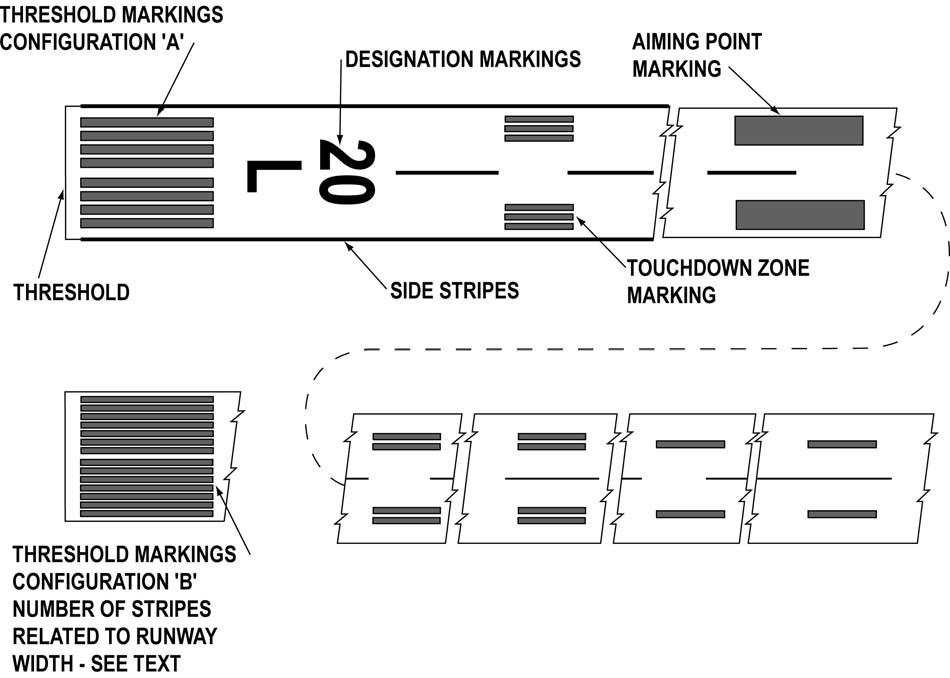
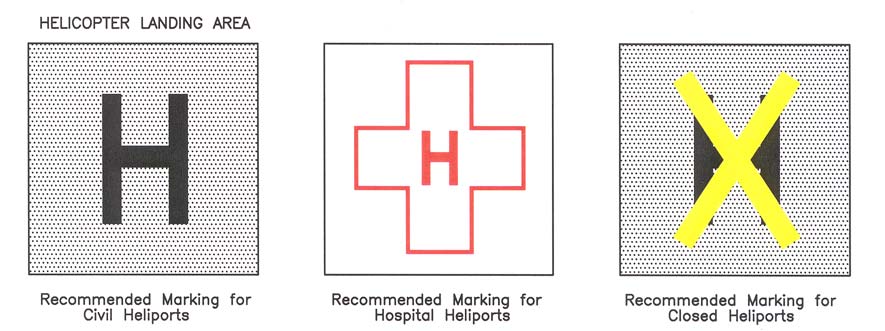


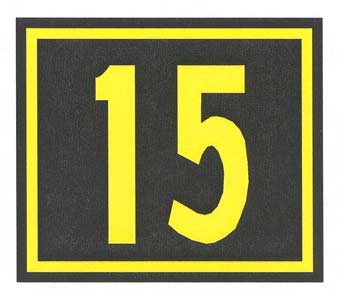

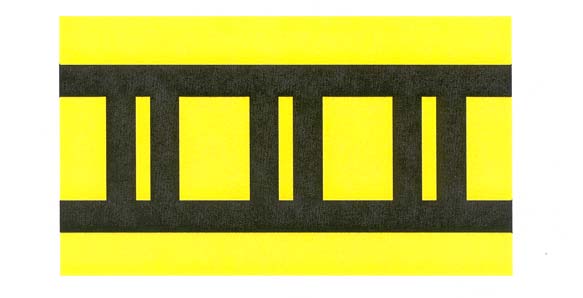
AIM 2-3-5. Holding Position Markings
For runways, these markings indicate where an aircraft is supposed to stop when approaching a runway. They consist of four yellow lines, two solid and two dashed, spaced six or twelve inches apart, and extending across the width of the taxiway or runway. The solid lines are always on the side where the aircraft is to hold.
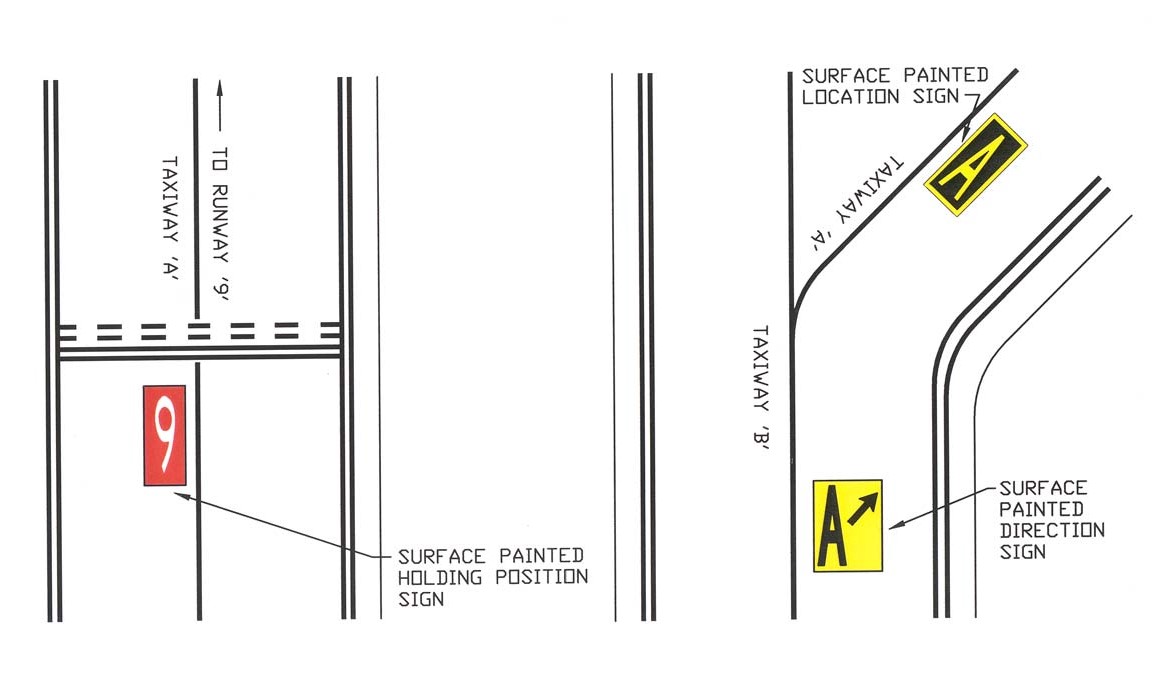
AIM 2-3-8. Mandatory Instruction Signs
Mandatory instruction signs are used to denote:
- An entrance to a runway or critical area
- Areas where an aircraft is prohibited from entering
Typical applications are:
- Runway Holding Position Sign
- Runway Approach Area Holding Position Sign
- ILS Critical Area Holding Position Sign
- No Entry Sign
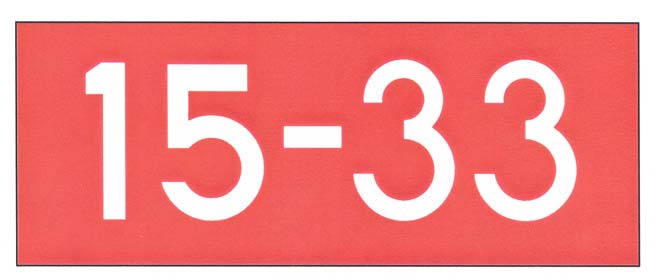
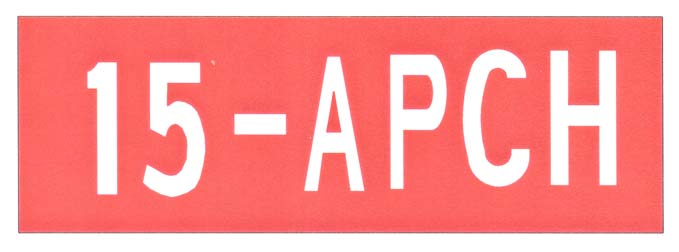
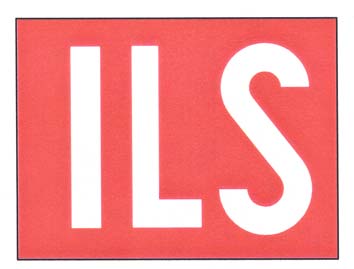
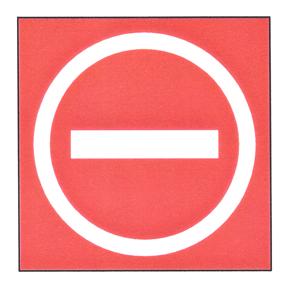
AIM 2-3-11. Destination Signs
Destination signs always have an arrow showing the direction of the taxiing route to a destination on the airport.
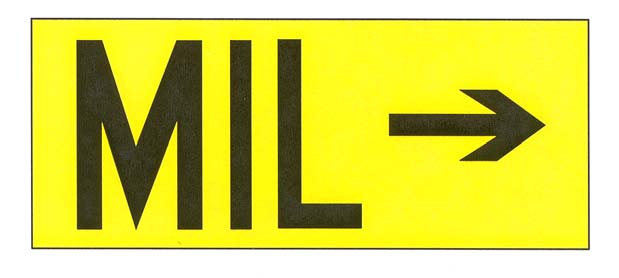
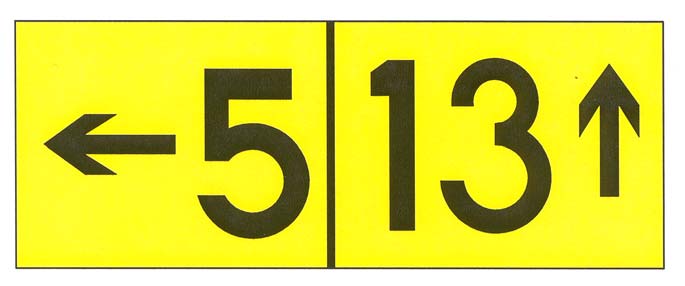
AIM 3-1-5. VFR Cruising Altitudes and Flight Levels
If you are more than 3,000 feet above the surface:
| Magnetic course | Cruising altitude |
|---|---|
| 0° to 179° | Odd thousands MSL, plus 500 feet |
| 180° to 359° | Even thousands MSL, plus 500 feet |
AIM 3-2-1. Controlled Airspace
Class A, Class B, Class C, Class D, and Class E
Traffic Advisories will be provided to all aircraft as the controller's work situation permits.
Safety Alerts are mandatory services and are provided to ALL aircraft. There are two types:- Terrain/Obstruction Alert
- Aircraft Conflict/Mode C Intruder Alert
AIM 3-2-3. Class B Airspace
Custom airspace dimensions with two or more layers up to 10,000 feet MSL
Requirements:
- Private pilot certificate or student pilot certificate with endorsement
- Two-way radio
- Mode C transponder within 30 NM
- ATC clearance to enter or depart Class B airspace
Pilots operating in VFR corridors are urged to use frequency 122.750 MHz for the exchange of aircraft position information
AIM 3-2-4. Class C Airspace
Generally consists of two layers surrounding an airport:
- Surface to 4,000 feet within a 5 NM radius
- 1,200 feet to 4,000 feet within a 10 NM radius
Requirements:
- Two-way radio
- Mode C transponder
- ATC must respond with call sign to enter
- No faster than 200 knots at or below 2,500 feet AGL within 4 NM
AIM 3-2-5. Class D Airspace
Generally consists of airspace from the surface to 2,500 feet AGL within a 4 NM radius of an airport.
In part-time surface areas, charts will specify "other times CLASS E" or "other times CLASS G".
Requirements:
- Two-way radio
- ATC must respond with call sign to enter
- No faster than 200 knots at or below 2,500 feet AGL within 4 NM
AIM 3-2-6. Class E Airspace
Unless otherwise specified, the airspace from 1,500 feet AGL or 14,500 feet MSL to 18,000 feet MSL overlying the 48 contiguous states and including the waters within nautical 12 miles from the coast.
Most charts specify the floor at 700 feet AGL or 1200 feet AGL.
AIM 3-3-1. Class G Airspace
Class G airspace (uncontrolled) is that portion of airspace that has not been designated as Class A, Class B, Class C, Class D, or Class E airspace.
AIM 3-4-2. Prohibited Areas
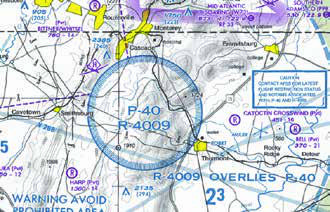
Flight is prohibited for security or other reasons associated with the national welfare.
AIM 3-4-3. Restricted Areas
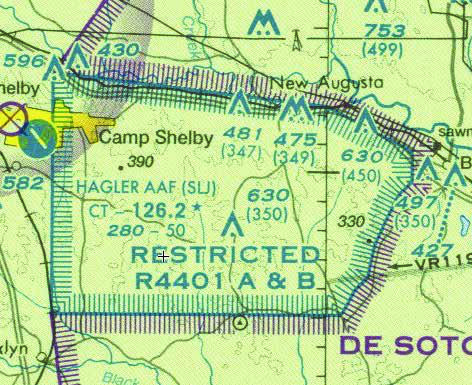
Requires authorization from controlling agency between the designated altitudes and during the time of designation.
Unusual, often invisible, hazards to aircraft such as:
- artillery firing
- aerial gunnery
- guided missiles
AIM 3-4-5. Military Operations Areas
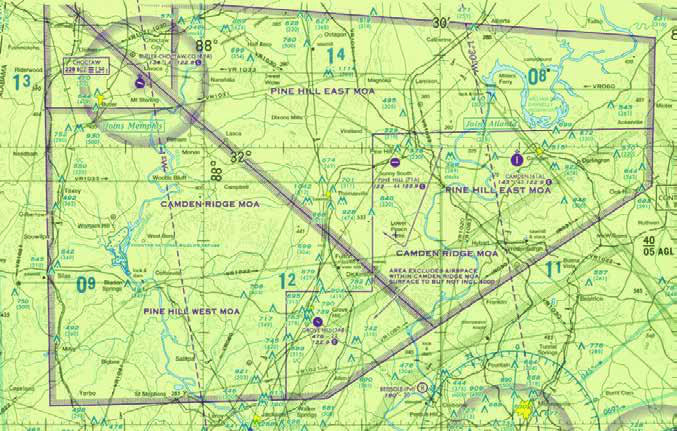
Established for separating military training activities from IFR traffic.
Activities include:
- Air combat
- Air intercepts
- Aerobatics
- Formation training
- Low-altitude flight
Prior to entering an active MOA, pilots should contact the controlling agency for traffic advisories.
AIM 3-4-7. Controlled Firing Areas
Activity hazardous to aircraft.
- Activities are suspended when spotters indicate an aircraft may be approaching
- Not depicted on charts
AIM 3-4-8. National Security Areas
Pilots are requested to voluntarily avoid flying through NSAs.
NOTAMs may also be issued which temporarily prohibit flight in NSAs.
AIM 3-5-5. Published VFR Routes
Published VFR Routes are for transitioning around, under and through complex airspace such as Class B airspace.
Types:
- VFR Flyways
- VFR Corridors
- Class B Airspace VFR Transition Routes
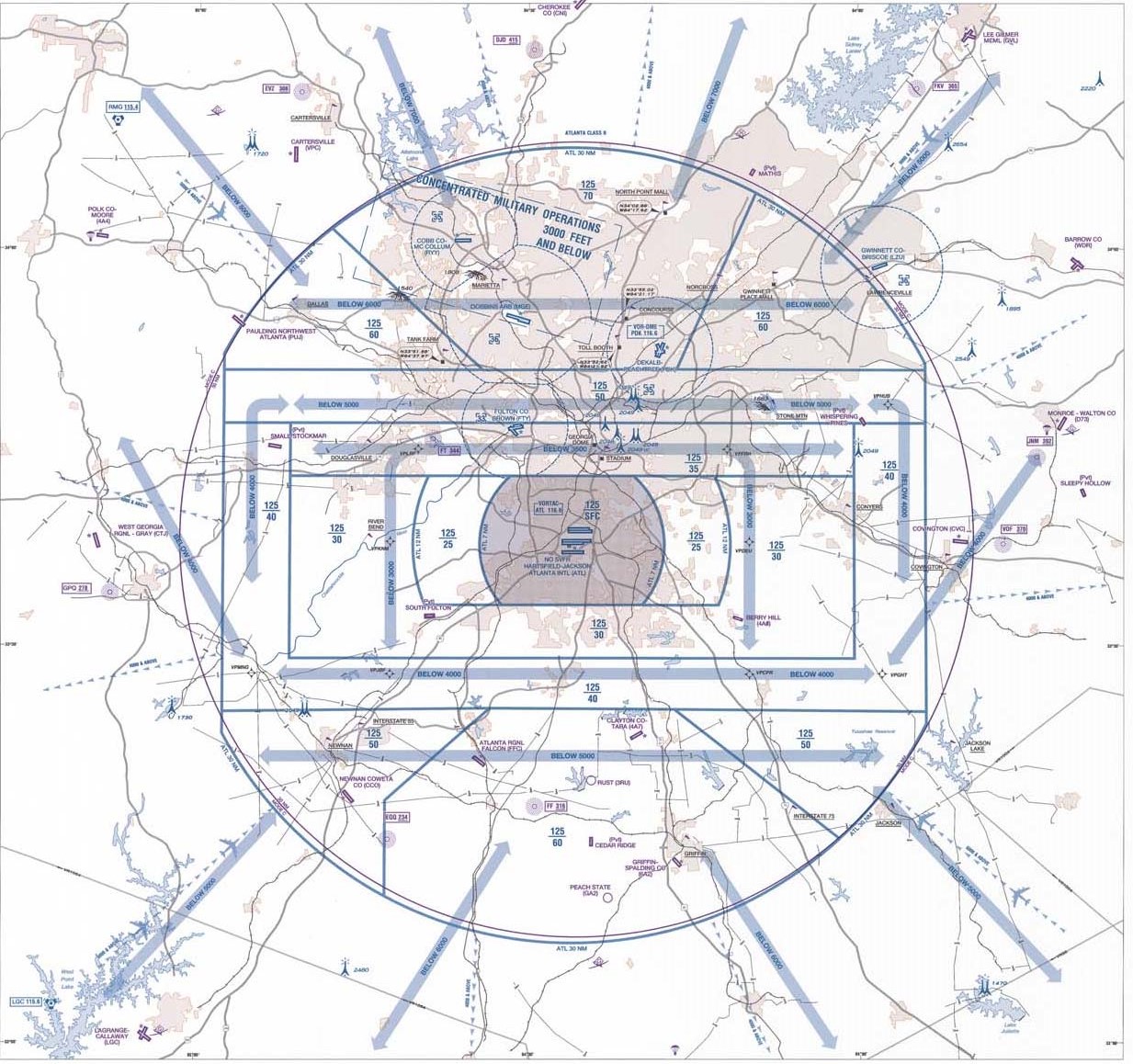
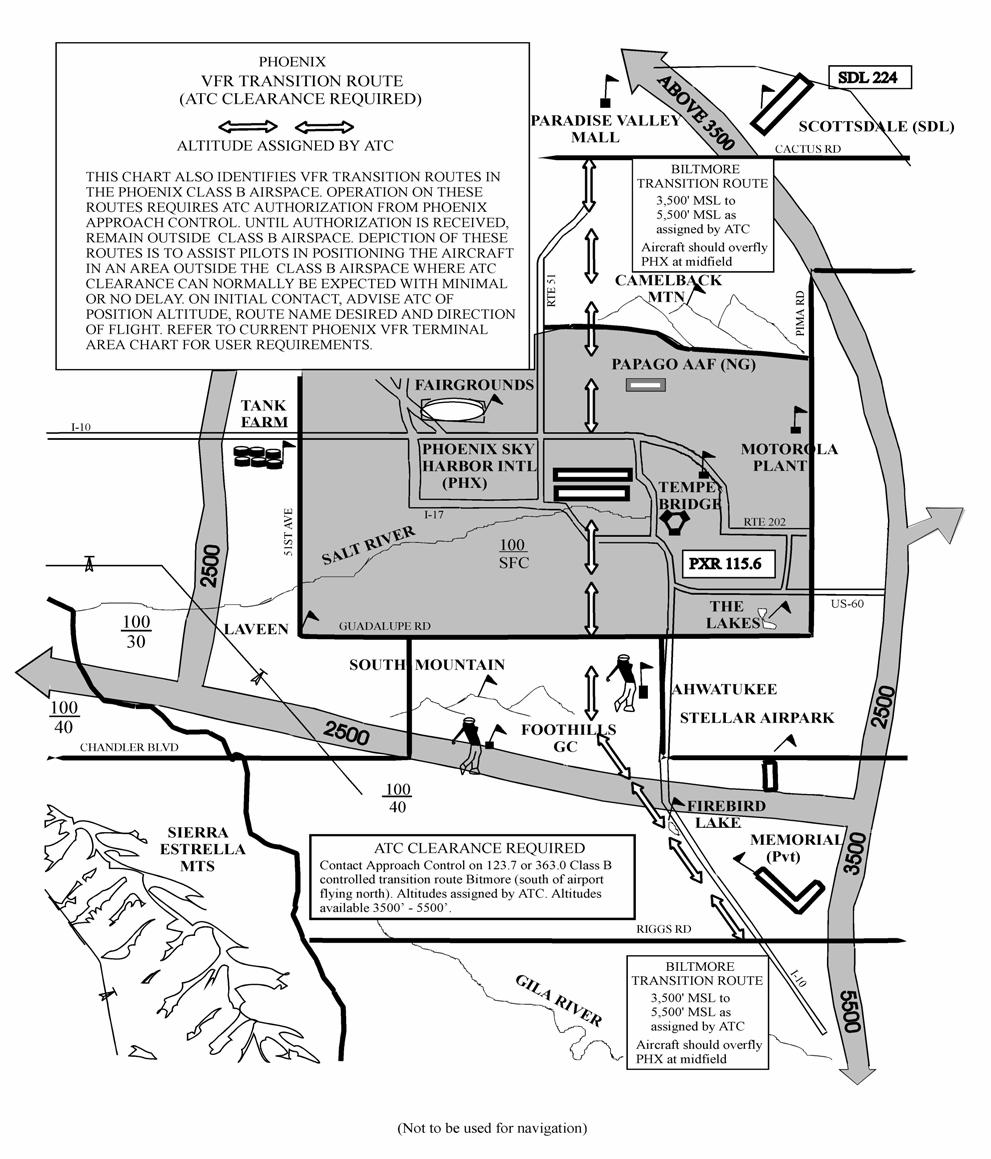
AIM 4-1-9. Traffic Advisory Practices at Airports Without Operating Control Towers
Be alert, not all aircraft have radios.
A Common Traffic Advisory Frequency is designated for aircraft flying to or from an airport without an operating control tower.
Self-announce:
- before taxiing
- before taxiing on the runway for departure
- 10 miles out when inbound
- when entering downwind, base, and final
- when exiting the runway
Recommended phraseology:
- Inbound - Strawn traffic, Apache Two Two Five Zulu, (position), (altitude), (descending) or entering downwind/base/final (as appropriate) runway one seven full stop, touch−and−go, Strawn
- Outbound - Strawn traffic, Queen Air Seven One Five Five Bravo (location on airport) taxiing to runway two six Strawn. Strawn traffic, Queen Air Seven One Five Five Bravo departing runway two six. Departing the pattern to the (direction), climbing to (altitude) Strawn.
AIM 4-1-11. Designated UNICOM/MULTICOM Frequencies
| Frequency | Use |
|---|---|
|
122.700 MHz 122.725 MHz 122.800 MHz 122.975 MHz 123.000 MHz 123.050 MHz 123.075 MHz |
Airports without an operating control tower |
| 122.900 MHz | Activities of a temporary, seasonal, emergency nature or search and rescue, as well as, airports with no tower, FSS, or UNICOM. |
| 122.925 MHz | Forestry management and fire suppression, fish and game management and protection, and environmental monitoring and protection. |
| 122.950 MHz | Airports with a control tower or FSS on airport. |
| 122.750 MHz | Air-to-air communication (private fixed wing aircraft). |
| 123.025 MHz | Air-to-air communications (general aviation helicopters). |
|
123.300 MHz 123.500 MHz |
Aviation instruction, Glider, Hot Air Balloon (not to be used for advisory service). |
AIM 4-1-13. Automatic Terminal Information Service (ATIS)
ATIS is the continuous broadcast of recorded noncontrol information in selected high activity terminal areas.
ATIS information includes:
- Airport/facility name
- Phonetic letter code
- Time of the latest weather sequence (UTC)
-
Weather information consisting of:
- Wind direction and velocity
- Visibility
- Obstructions to vision
- Present weather consisting of: sky condition, temperature, dew point, altimeter, a density altitude advisory when appropriate, and other pertinent remarks included in the official weather observation
AIM 4-1-15. Radar Traffic Information Service
Pilots receiving this service are advised of any radar target observed on the radar display which may be in such proximity to the position of their aircraft or its intended route of flight that it warrants their attention.
AIM 4-1-18. Terminal Radar Services for VFR Aircraft
Basic radar service:
- Safety alerts.
- Traffic advisories.
- Limited radar vectoring (on a workload permitting basis).
- Sequencing at locations where procedures have been established for this purpose and/or when covered by a Letter of Agreement.
AIM 4-1-20. Transponder Operation
Aircraft should operate with the transponder in the altitude reporting mode and ADS-B Out transmissions enabled (if equipped) at all airports, any time the aircraft is positioned on any portion of an airport movement area.
AIM 4-2-3. Contact Procedures
Use the following format:
- Name of the facility being called
- Your full aircraft identification
- When operating on an airport surface, state your position
- The type of message to follow or your request if it is short
- The word "Over" if required
Example:
- New York Radio, Mooney Three One One Echo.
- Columbia Ground, Cessna Three One Six Zero Foxtrot, south ramp.
- Miami Center, Baron Five Six Three Hotel, request V−F−R traffic advisories.
AIM 4-2-9. Altitudes and Flight Levels
When stating altitudes, state the separate digits of the thousands plus the hundreds if appropriate.
AIM 4-2-10. Directions
When stating directions, use three digits and magnetic direction. When using true direction, add the word "true".
AIM 4-2-11. Speed
When stating speeds, state the separate digits followed by the word "knots".
AIM 4-2-12. Time
When stating time, use UTC. When using local time, add the word "local".
AIM 4-2-13. Communications with Tower when Aircraft Transmitter or Receiver or Both are Inoperative
If receiver is inoperative:
- remain outside airspace
- observe traffic
- advise tower of intention to land and request light signals
- enter the traffic pattern
- continue making radio calls
If transmitter is inoperative:
- remain outside airspace
- observe traffic
- acknowledge tower transmissions with gentle banks in opposite directions
- at night, flash landing or navigation lights
AIM 4-3-3. Traffic Patterns
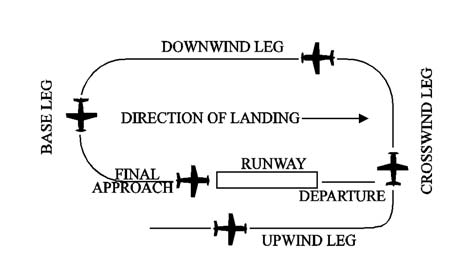
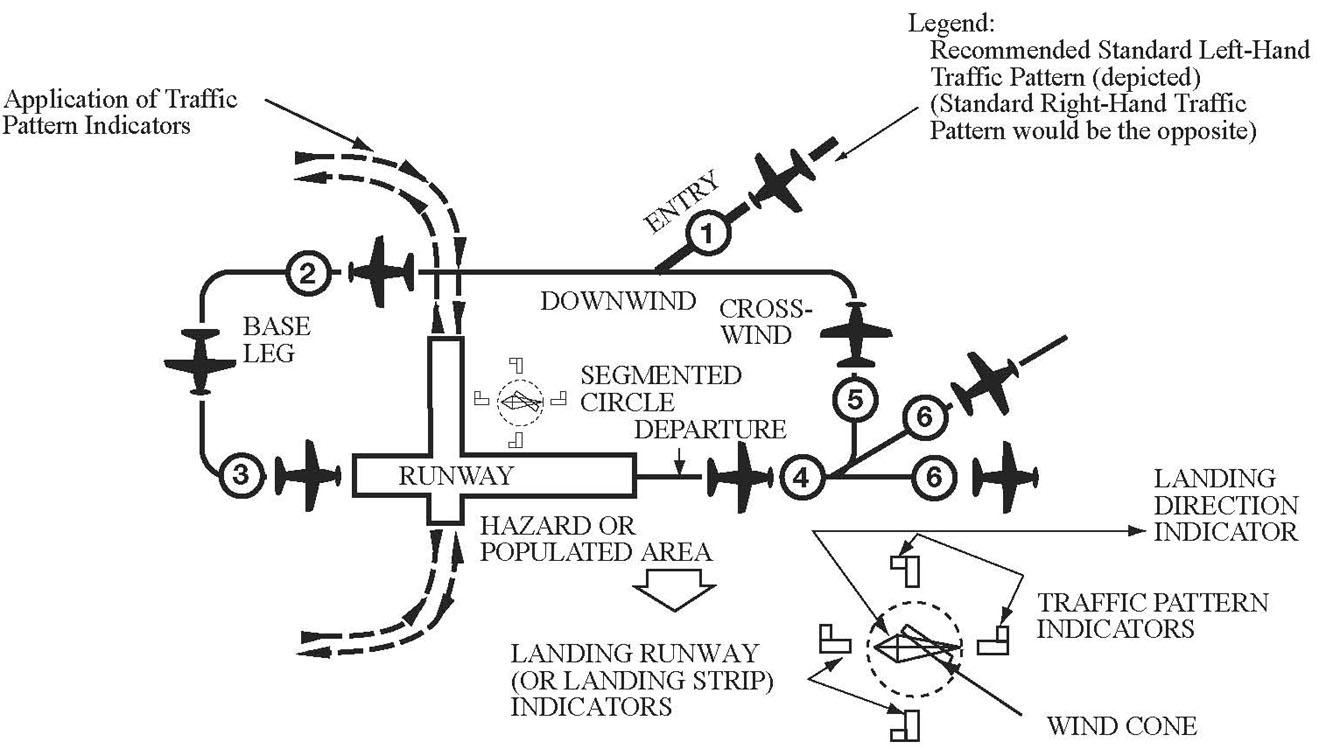
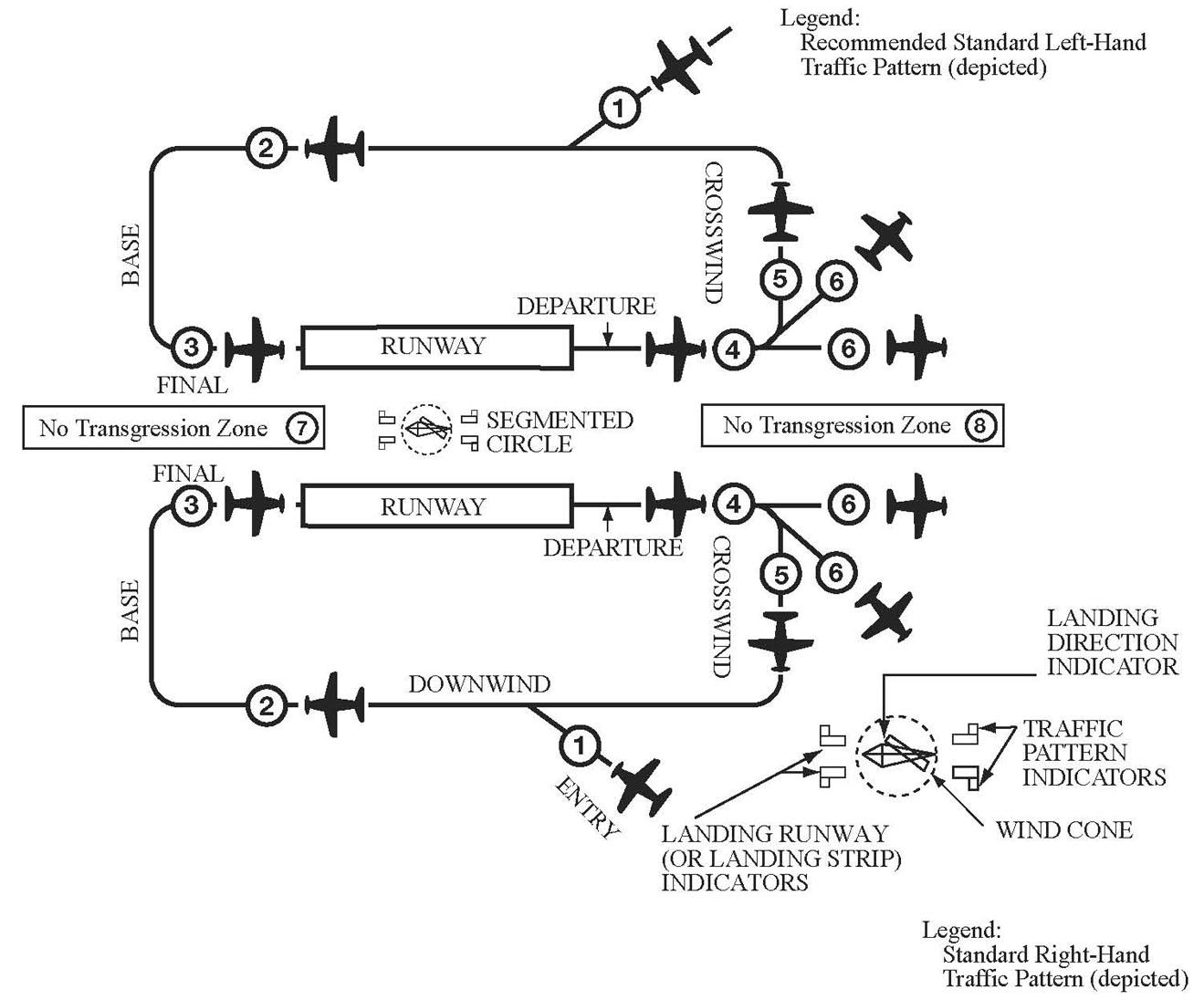
AIM 4-3-4. Visual Indicators at Airports Without an Operating Control Tower
A segmented circle system consists of:
- A segmented circle
- A wind cone, wind sock, or wind tee
- A tetrahedron indicating landing direction
- Landing strip indicators
- Traffic pattern indicators
AIM 4-3-14. Communications
The majority of ground frequencies are between 121.6-121.9 MHz. If ground frequency is in the 121 MHz bandwidth, the controller may omit that part. e.g. "CONTACT GROUND POINT SEVEN".
AIM 4−3−17. VFR Helicopter Operations at Controlled Airports
Helicopter pilots should:
- avoid the flow of fixed-wing aircraft to minimize overall delays
- advise ATC if clearances produce dangerous conditions
- air taxi when possible to minimize downwash, conserve fuel, and save time
Whenever possible, takeoff clearance will be issued in lieu of extended hover/air taxi operations:
CLEARED FOR TAKEOFF FROM (taxiway, helipad, runway number, etc.), MAKE RIGHT/LEFT TURN FOR (direction, heading, NAVAID radial) DEPARTURE/DEPARTURE ROUTE (number, name, etc.)
If takeoff is requested from nonmovement areas, an area not authorized for helicopter use, an area not visible from the tower, an unlighted area at night, or an area off the airport:
DEPARTURE FROM (requested location) WILL BE AT YOUR OWN RISK (additional instructions, as necessary). USE CAUTION (if applicable).
The pilot is responsible for operating in a safe manner and should exercise due caution.
Similar phraseology is used for helicopter landing operations. Every effort will be made to permit helicopters to proceed direct and land as near as possible to their final destination on the airport.
AIM 4-3-18. Taxiing
When taxi instructions are received from the controller, pilots should always read back:
- The runway assignment
- Any clearance to enter a specific runway
- Any instruction to hold short of a specific runway or line up and wait
AIM 4-3-23. Use of Aircraft Lights
- Position lights are required from sunset to sunrise.
- Anti-collision lights are required day and night unless the pilot determines their light constitutes a hazard.
- The FAA encourages pilots to turn on landing lights during takeoff, when operating within 10 miles of any airport, or in conditions of reduced visibility.
AIM 4-4-6. Special VFR Clearances
Special VFR is provided traffic permitting, providing such flight will not delay IFR operations.
Helicopters must only remain clear of clouds.
Pilot's Handbook of Aeronautical Knowledge
Chapter 17 - Aeromedical Factors
Hypoxic Hypoxia
Hypoxic hypoxia is a result of insufficient oxygen available to the body as a whole. It can be caused by the reduction in partial pressure of oxygen at high altitude.
Hypemic Hypoxia
Hypemic means "not enough blood". Hypemic hypoxia occurs because hemoglobin, the actual blood molecule that transports oxygen, is chemically unable to bind oxygen molecules. The most common form of hypemic hypoxia is CO poisoning. It may also be due to reduced blood volume or anemia. Blood volume can require several weeks to return to normal following a blood donation.
Stagnant Hypoxia
Stagnant means "not flowing", and stagnant hypoxia or ischemia results when the oxygen-rich blood in the lungs is not moving to the tissues that need it. During flight, stagnant hypoxia can occur with excessive Gs. Cold temperatures can also reduce circulation and decrease the blood supplied to extremities.
Histotoxic Hypoxia
The inability of the cells to effectively use oxygen is defined as histotoxic hypoxia. In this case, enough oxygen is being transported to the cells that need it, but they are unable to make use of it. This impairment of cellular respiration can be caused by alcohol and other drugs, such as narcotics and poisons.
Symptoms of Hypoxia
- Cyanosis (blue fingernails and lips)
- Headache
- Decreased response to stimuli and increased reaction time
- Impaired judgment
- Euphoria
- Visual impairment
- Drowsiness
- Lightheaded or dizzy sensation
- Tingling in fingers and toes
- Numbness
Middle Ear and Sinus Problems
To remedy this often painful condition, pinch the nostrils shut, close the mouth and lips, and blow slowly and gently into the mouth and nose. This procedure forces air through the Eustachian tube into the middle ear.
Altitude-Induced Decompression Sickness
If nitrogen is forced to leave the body too rapidly when exposed to decreased barometric pressures, bubbles form. The most common symptom is joint pain, which is known as "the bends."
If decompression sickness occurs:
- Put on oxygen mask immediately and switch the regulator to 100 percent oxygen.
- Begin an emergency descent and land as soon as possible.
- If one of the symptoms is joint pain, keep the affected area still; do not try to work pain out by moving the joint around.
The recommended waiting time before flight after scuba diving is 24 hours. If remaining below flight altitudes of up to 8,000 feet after diving that does not require controlled ascent the recommend time is at least 12 hours.
Night Vision
Lack of rods near the fovea create a night blind spot in the center of the field of vision.
Pilots must look 5°-10° off center of the object in order for the object to be seen.
The rods can take approximately 30 minutes to fully adapt to darkness. A bright light, however, can completely destroy night adaptation, leaving night vision severely compromised while the adaptation process is repeated.
Lack of oxygen to the rods significantly reduces their sensitivity. Without supplemental oxygen, an individual's night vision declines measurably at pressure altitudes above 4,000 feet.
Missing or postponing meals can cause low blood sugar, which impairs night flight performance.
Other Factors
- Motion Sickness
- Stress
- Fatigue
- Dehydration
Helicopter Flying Handbook
Chapter 11 - Helicopter Emergencies and Hazards
Autorotation
An autorotative descent is a power-off maneuver in which the engine is disengaged from the main rotor system and the rotor blades are driven solely by the upward flow of air through the rotor.
Settling With Power (Vortex Ring State)
The following combination of conditions is likely to cause settling in a vortex ring state in any helicopter:
- A vertical or nearly vertical descent of at least 300 fpm.
- The rotor system must be using some of the available engine power (20–100 percent)
- The horizontal velocity must be slower than effective translational lift.
Retreating Blade Stall
To generate the same amount of lift across the rotor disk, the advancing blade flaps up while the retreating blade flaps down. This causes the AOA to decrease on the advancing blade, which reduces lift, and increase on the retreating blade, which increases lift. At some point as the forward speed increases, the low blade speed on the retreating blade, and its high AOA cause a stall and loss of lift.
Dynamic Rollover
Dynamic rollover begins when the helicopter starts to pivot laterally around its skid or wheel.
Quickly reducing collective pitch is the most effective way to stop dynamic rollover from developing.
Low-G Conditions and Mast Bumping
Chapter 14 - Effective Aeronautical Decision-Making
I'M SAFE checklist
- Illness
- Medication
- Stress
- Alcohol
- Fatigue
- Emotion
Four Risk Elements
- Pilot - The pilot's fitness to fly must be evaluated, including com-petency in the helicopter, currency, and flight experience.
- Aircraft - The helicopter performance, limitations, equipment, and airworthiness must be determined.
- EnVironment - Factors such as weather and airport conditions must be examined.
- External Pressures - The purpose of the flight is a factor that influences the pilot's decision on undertaking or continuing the flight.
Helicopter Flying Handbook
Chapter 11 - Helicopter Emergencies and Hazards
Autorotation
An autorotative descent is a power-off maneuver in which the engine is disengaged from the main rotor system and the rotor blades are driven solely by the upward flow of air through the rotor.
Settling With Power (Vortex Ring State)
The following combination of conditions is likely to cause settling in a vortex ring state in any helicopter:
- A vertical or nearly vertical descent of at least 300 fpm.
- The rotor system must be using some of the available engine power (20–100 percent)
- The horizontal velocity must be slower than effective translational lift.
Retreating Blade Stall
To generate the same amount of lift across the rotor disk, the advancing blade flaps up while the retreating blade flaps down. This causes the AOA to decrease on the advancing blade, which reduces lift, and increase on the retreating blade, which increases lift. At some point as the forward speed increases, the low blade speed on the retreating blade, and its high AOA cause a stall and loss of lift.
Dynamic Rollover
Dynamic rollover begins when the helicopter starts to pivot laterally around its skid or wheel.
Quickly reducing collective pitch is the most effective way to stop dynamic rollover from developing.
Low-G Conditions and Mast Bumping
Chapter 14 - Effective Aeronautical Decision-Making
I'M SAFE checklist
- Illness
- Medication
- Stress
- Alcohol
- Fatigue
- Emotion
Four Risk Elements
- Pilot - The pilot's fitness to fly must be evaluated, including com-petency in the helicopter, currency, and flight experience.
- Aircraft - The helicopter performance, limitations, equipment, and airworthiness must be determined.
- EnVironment - Factors such as weather and airport conditions must be examined.
- External Pressures - The purpose of the flight is a factor that influences the pilot's decision on undertaking or continuing the flight.
R22 Rotorcraft Flight Manual
R22 POH - Section 1 - General
Main Rotor
| Articulation | Free to teeter and cone, rigid inplane |
| Tip Speed @ 100% RPM | 672 FPS |
Tail Rotor
| Articulation | Free to teeter, rigid inplane |
| Tip Speed @ 100% RPM | 599 FPS |
Drive System
| Engine to Upper Sheave | Vee-belts with .8536:1 reducing ratio |
| Upper Sheave to Drive Line | Sprag clutch |
| Drive Line to Main Rotor | Spiral-bevel gears with 11:47 speed reducing ratio |
| Drive Line to Tail Rotor | Spiral-bevel gears with 3:2 speed increasing ratio |
| Overall Engine to Main Rotor | 1:5 speed reducing ratio |
| Overall Engine to Tail Rotor | 1:1.28 speed increasing ratio |
Powerplant
| Model | Lycoming O-360-J2A |
| Type | Four cylinder, horizontally opposed, direct drive, air cooled, carbureted, normally aspirated |
| Displacement | 361.0 cubic inches |
| Normal Rating | 145 BHP (derated) @ 2700 RPM |
| Maximum Continuous Rating | 124 BHP @ 2652 RPM |
| 5-minute Takeoff Rating | 131 BHP @ 2652 RPM |
R22 POH - Section 2 - Limitations
Airspeed Limits
Rotor Speed Limits
| Tachometer Reading | Actual RPM | ||
|---|---|---|---|
| Power On | Minimum | 101% | 515 RPM |
| Maximum | 104% | 530 RPM | |
| Power Off | Minimum | 90% | 459 RPM |
| Maximum | 110% | 561 RPM | |
Powerplant Limits
| Engine Maximum Speed | 2652 RPM (104%) |
| Cylinder Head Max Temperature | 500°F |
| Oil Maximum Temperature | 245°F |
| Minimum Oil Pressure During Idle | 25 PSI |
| Minimum Oil Pressure During Flight | 55 PSI |
| Maximum Oil Pressure During Flight | 95 PSI |
| Maximum Oil Pressure During Warm Up | 115 PSI |
| Minimum Oil Quantity For Takeoff | 4 qt |
Weight Limits
| Minimum Gross Weight | 920 lb |
| Maximum Gross Weight | 1370 lb |
| Maximum Weight Per Seat | 240 lb |
| Maximum Weight in Baggage Compartment | 50 lb |
R22 POH - Section 3 - Emergency Procedures
Power Failure - General
An engine failure may be indicated by a change in noise level, nose left yaw, an oil pressure light, or decreasing engine RPM.
A drive system failure may be indicated by an unusual noise or vibration, nose right or left yaw, or decreasing rotor RPM while engine RPM is increasing.
In case of power failure, immediately lower collective to enter autorotation.
Power Failure below 8 feet
- Apply right pedal as required.
- Allow aircraft to settle.
- Raise collective just before touchdown to cushion landing.
Power Failure between 8 feet and 500 feet AGL
- Lower collective to maintain rotor RPM.
- Adjust collective to keep rotor RPM between 97% and 110%.
- Maintain airspeed until ground is approached then begin cyclic flare to reduce rate of descent and forward speed.
- At about 8 feet AGL, apply forward cyclic to level ship and raise collective just before touchdown to cushion landing.
Power Failure above 500 feet AGL
- Lower collective to maintain rotor RPM.
- Establish a steady glide at approximately 65 KIAS.
- Adjust collective to keep RPM between 97% and 110%.
- Select landing spot and, if altitude permits, maneuver so landing will be into wind.
- A restart may be attempted at the pilot's discretion.
- If unable to restart, turn unnecessary switches and fuel valve off.
- At 40 feet AGL begin cyclic flare to reduce raite of descent and forward speed.
- At about 8 feet AGL, apply forward cyclic to level ship and raise collective just before touchdown to cushion landing.
Max Glide Distance Configuration
- Airspeed approximately 75 KIAS
- Rotor RPM approximately 90%
- Best glide ratio is about 4:1
Air Restart Procedure
- Mixture full rich
- Primer down and locked
- Throttle closed, then cracked slightly
- Actuate starter with left hand
Emergency Water Landing - Power Off
- Follow same procedures as for power failure over land until contacting water. If time permits, unlatch doors prior to water contact.
- Apply lateral cyclic when aircraft contacts water to stop rotors.
- Release seat belt and quickly clear aircraft when rotors stop.
Emergency Water Landing - Power On
- Descend to hover above water.
- Unlatch doors.
- Allow passengers to exit aircraft.
- Fly to safe distance from passengers.
- Switch battery and alternator OFF.
- Roll throttle off into overtravel spring.
- Keep aircraft level and apply full collective as aircraft contacts water.
- Apply lateral cyclic to stop rotors.
- Release seat belt and quickly clear aircraft when rotors stop.
Loss of Tail Rotor Thrust in Forward Flight
- Immediately enter autorotation.
- Maintain at least 70 KIAS if practical.
- Select landing site, roll throttle off into overtravel spring, and perform autorotation landing.
If a suitable landing site is not available, the vertical stabilizers may permit limited controlled flight at lower power settings and airspeeds above 70 KIAS; however, prior to reducing airspeed, enter full autorotation.
Loss of Tail Rotor Thrust in Hover
- Immediately roll throttle off into overtravel spring and allow aircraft to settle.
- Raise collective just before touchdown to cushion landing.
Engine Fire During Start on Ground
- Continue cranking and attempt to start which would suck flames and excess fuel into engine.
- If engine starts, run at 50-60% RPM for a short time.
- Fuel mixture - OFF.
- Fuel valve - OFF.
- Batter switch - OFF.
- If time permits, apply rotor brake to stop rotors.
- Exit helicopter.
Engine Fire in Flight
- Enter autorotation.
- Cabin heat - OFF.
- Cabin vent - ON.
- If engine is running, perform normal landing, then fuel mixture OFF and fuel valve OFF.
- If engine stops running, fuel valve OFF and complete autorotation landing.
- Battery switch - OFF.
- If time permits, apply rotor brake to stop rotors.
- Exit helicopter.
Electrical Fire in Flight
- Battery and alternator switches - OFF.
- Cabin vent - ON.
- Land immediately.
- Fuel mixture OFF and fuel valve OFF.
- If time permits, apply rotor brake to stop rotors.
- Exit helicopter.
Tachometer Failure
If rotor or engine tach malfunctions in flight, use remaining tach to monitor RPM. If it is not clear which tach is malfunctioning or if both tachs malfunction, allow governor to control RPM and land as soon as practical.
Governor Failure
Grip throttle firmly to override the governor, then switch the governor off. Complete flight using manual throttle control.
Warning/Caution Lights
If a light causes excessive glare at night, bulb may be unscrewed or circuit breaker pulled to eliminate glare during landing.
| OIL | |
| MR TEMP | |
| MR CHIP | |
| TR CHIP | |
| LOW FUEL | |
| CLUTCH | |
| ALT | |
| BRAKE | |
| STARTER-ON | |
| GOV-OFF | |
| CARBON MONOXIDE | |
| FULL THROTTLE |
Advisory Circulars
AC 39-7D - Airworthiness Directives
AD Categories
- Notice of Proposed Rulemaking
- Final Rule; Request for Comment
- Emergency ADs
Robinson Safety Notices
SN-1 - Inadvertent Actuation of Mixture Control in Flight
Always reach around the left side of the cyclic when actuating trim. Use the mixture control guard.
SN-9 - Many Accidents Involve Dynamic Rollover
To avoid dynamic rollover:
- Only practice hover autorotations into less than 10 knots of wind.
- Avoid obstacles on the ground.
- Use a two-step liftoff.
- Hover at least five feet above ground when practicing sideward or rearward flight.
To correct, quickly apply down collective.
SN-10 - Fatal Accidents Caused by Low RPM Rotor Stall
The conditioned reflex to low rotor RPM must be to simultaneously add throttle and lower collective. In forward flight, apply aft cyclic.
SN-11 - Low-G Pushovers - Extremely Dangerous
Never perform a low-G pushover.
To prevent mast bumping in a low-G situation, apply an immediate gentle aft cycle before correcting right roll.
SN-13 - Do Not Attach Items to the Skids
Do not attempt to carry any external load or object attached to the landing gear.
SN-15 - Fuel Exhaustion Can Be Fatal
To avoid fuel exhaustion:
- Never rely solely on the fuel gage or low fuel warning light.
- Check fuel level in the tanks visually.
- Drain fuel to check for water contamination during preflight.
- Continually check fuel levels in flight.
- Always land to refuel before the main tank fuel gage reads less than 1/4 full.
SN-16 - Power Lines Are Deadly
- Fly directly over towers when crossing power lines.
- Maintain at least 500 feet AGL when possible.
SN-17 - Never Exit Helicopter With Engine Running
- Never exit helicopter with engine running.
- Hold controls when boarding passengers.
- Never land in tall dry grass.
SN-18 - Loss of Visibility Can Be Fatal
- Take corrective action before visibility is lost.
- Use good judgement and land in bad weather.
SN-19 - Flying Low Over Water is Very Hazardous
Flying over water can interfere with normal depth perception. Maintain 500 feet AGL whenever possible and avoid maneuvers below 200 feet AGL.
SN-20 - Beware of Demonstration or Initial Training Flights
Instructors should be prepared for when the student makes sudden incorrect control movements.
SN-22 - Vortex Ring State Catches Many Pilots by Surprise
To avoid vortex ring state, reduce rate of descent before reducing airspeed. A good rule to follow is never allow your airspeed to be less than 30 knots until your rate-of-descent is less than 300 feet per minute.
There are two techniques to recover from vortex ring state:
- Reduce collective to reduce downwash, then forward cyclic to fly forward out of the downwash. This can result in significant altitude loss, which may not be acceptable on an approach.
- Lateral cyclic to fly sideways out of the downwash, assisted by tail rotor thrust. This is known as the Vuichard recovery.
SN-23 - Walking Into Tail Rotor Can Be Fatal
- Passengers must be instructed to maintain eye contact when approaching the helicopter.
- Always turn on strobe when rotors are turning.
- Be careful of unseen people approaching from the rear.
SN-24 - Low RPM Rotor Stall Can Be Fatal
Rotor stall accidents most often occur close to the ground, but a rotor stall above 40 or 50 feet AGL is most likely to be fatal.
When the rotor stalls, the retreating blade stalls first, resulting in "rotor blow-back", then the upward flow of air from under the tail causes a dive.
SN-25 - Carburetor Ice
Carburetor ice can occur at OATs as high as 30°C.
Even in dry air, local conditions such as a nearby body of water can be conducive to carburetor ice.
When in doubt, assume conditions are conducive to carburetor ice and apply carb heat as required.
Use full carb heat during run-up to preheat the induction system.
Full carb heat requires approximately 1.5" Hg. The engine can produce full power at lower altitudes with full heat, but at high altitudes, avoid using more heat than required to avoid reaching full throttle at less than maximum power.
SN-26 - Night Flight Plus Bad Weather Can Be Deadly
There are many hazards related to night flight. Never fly at night unless you have clear weather with unlimited or very high ceilings and plenty of celestial or ground lights for reference.
SN-27 - Surprise Throttle Chops Can Be Deadly
Instructors should announce "power failure" before smoothly rolling off the throttle and keeping the right leg muscles tight in case the student presses the wrong pedal.
Simulated engine failures should be performed within glide distance of a safe touchdown area.
SN-28 - Listen For Impending Bearing Failure
An impending ball bearing failure is usually preceded by a noticeable increase in noise, typically several hours before the bearing completely fails.
During startup, uncover one ear and listen to the sound of the drive system. Upon hearing an unusual noise, immediately ground the aircraft and have bearings inspected.
Do not rely on telatemps to indicate bearing failure, as they may only black out once the bearing starts to disintegrate.
If the clutch light flickers or stays on for more than 10 seconds, pull the clutch circuit breaker and reduce power. Make a precautionary landing to inspect drive system and be prepared to enter autorotation.
SN-29 - Airplane Pilots High Risk When Flying Helicopters
Airplane pilots must be carefully trained to never abruptly push the cyclic forward.
SN-30 - Loose Objects Can Be Fatal
Loose objects flying out of the cabin and striking the tail rotor can cause failure of the tail rotor blade, resulting in a fatal accident.
- Ensure fuel caps and door hinge pins are secure.
- Stow or secure all loose objects in the cabin.
- Firmly latch all doors.
- Never fly with a left door removed.
SN-31 - Governor Can Mask Carb Ice
Apply carb heat as required to keep CAT out of yellow arc.
Apply full carb heat when manifold pressure is below 18 inches.
Carb heat assist will reduce carb heat when you lift off to a hover and may require readjustment in flight.
SN-32 - High Winds or Turbulence
Pilots should avoid flight in high winds or turbulence due to increased risk of mast bumping.
- Reduce airspeed to 60-70 knots in turbulence.
- Rest forearm on leg or apply a small amount of cyclic friction to minimum unintentional inputs.
- Do not overcontrol
- Avoid flying on the downwind side of obstacles where turbulence will likely be most severe.
SN-33 - Drive Belt Slack
Check drive belt slack during preflight to avoid belts jumping out of sheave grooves during engine start. The belt should deflect approximately 1.5" when pressed on just above the fan scroll.
After engine start, engage clutch and verify rotor turns within 5 seconds. If rotor does not turn within 5 seconds, shut down and have actuator adjusted.
SN-34 - Photo Flights - Very High Risk
Aerial survey and photo flights should only be conducted by well trained, experience pilots who:
- Have at least 500 hours PIC in helicopters and over 100 hours in the model flown.
- Have extensive training in both low RPM and settling-with-power recovery techniques.
- Are willing to say no to the observer or photographer.
SN-35 - Flying Near Broadcast Towers
High power radio broadcast towers (typically 50 kW or greater) may generate electromagnetic interference (EMI) with electrical systems. Early indications can be considerable radio squelch break or static in the intercom system. More severe effects include random illumination of warning lights or erratic engine governor and tachometer operation. In the worst cases, the governor may attempt to fully open or close the throttle.
To minimize the possibility of encountering EMI, do not fly within 1/2 mile of high power broadcast towers.
If EMI is encountered:
- Keep one hand on the throttle and turn governor off or be prepared to override governor if operation is abnormal.
- Monitor instruments carefully, and use cation not to overreact to a false instrument or warning light indication.
- Have electrical system assessed after flight.
SN-36 - Overspeeds During Liftoff
To avoid overspeeds during liftoff:
- Always confirm governor on before increasing RPM above 80%.
- Verify governor stabilizes engine RPM near top of green arc.
- Maintain relaxed grip on throttle allowing governor to control RPM.
SN-37 - Exceeding Operating Limits
Exceeding operating limits causes metal fatigue which will eventually result in sudden failure.
SN-38 - Practice Autorotations Cause Training Accidents
As the aircraft descends through 100 feet AGL, make an immediate power recovery unless all of the following conditions exist:
- Rotor RPM in middle of the green arc.
- Airspeed stabilized between 60 and 70 KIAS.
- A normal rate of descent, usually less than 1500 ft/min.
- Turns completed.
At density altitudes above 4000 feet, increase the decision point to 200 feet AGL or higher.
Practice should be limited to 3 or 4 consecutive autorotations.
Do not roll throttle to full idle. Reduce throttle smoothly for a visible needle split, then hold throttle firmly to override governor.
SN-39 - Unusual Vibrations
If a rotor is smooth after balancing but then goes out of balance again within a few flights, it should be inspected for indications of a fatigue crack.
If main rotor vibration rapidly increases or becomes severe during flight, land immediately. Do not attempt to continue flight.
SN-40 - Post-Crash Fires
Consider fire-retardant Nomex flight suits to reduce likelihood of severe burns.
SN-41 - Pilot Distractions
Reading charts, programming avionics, or attending to passengers are some common distractions that have cause pilots to lose control of the helicopter.
When hovering, keep both hands on the controls. If tuning a radio or other task is required, first land and reduce collective pitch.
When in forward flight, reduce power, slow down, and frequently look outside.
Never attempt to latch a door when hovering or in flight. It is safer to land first.
SN-42 - Unanticipated Yaw
Robinson tail rotors are designed to have a high level of authority and are unlikely to experience LTE. To avoid unanticipated yaw, pilots should be aware of conditions that may require large or rapid pedal inputs.
SN-43 - Use Extra Caution During Post-Maintenance Flights
Pilots should conduct a thorough preflight after maintenance has been performed. If possible, speak to the technicians and find out exactly what was done.
After track and balance work, always climb up to the rotor head for a close inspection of the pitch link and control tube fasteners.
Robinson Safety Videos
Energy Management
The power curve bottoms out around 53 KIAS.
This number determines:
- Maximum endurance
- Best rate of climb
- Minimum rate of descent
Above 53 KIAS, flight is natural and stable. It takes more power to go faster, less power to go slower.
Below 53 KIAS, flight is unstable. It takes more power to go slower, less power to go faster.
Stored Energy
The pilot has three places to store and retrieve energy.
- Rotor RPM
- Forward Speed
- Altitude
Forward Speed
Below 30 KIAS, there is less than 100 HP seconds of energy stored in forward speed.
Stored Energy II
At 90 KIAS and 500 feet AGL, energy is approximately distributed as follows:
| Storage Bin | HP-SEC |
|---|---|
| Rotor RPM | 100 |
| Airspeed | 800 |
| Altitude | 1100 |
Altitude energy is slow to recover, which is why it's important to maintain forward airspeed.
If no action is taken in an engine failure, main rotor stall occurs in approximately 1.1 seconds.
Recover 100 HP-Sec
In order to recover 100 HP-SEC
- RPM 104% to 75%
- Airspeed 90 to 84 KIAS
- Airspeed 60 to 50 KIAS
- Airspeed 32 to 0 KIAS
- Altitude - 46 feet
By using a minimum airspeed of 60 KIAS, an extra 100 HP-SEC can be recovered before going on the back side of the power curve.
Energy Management II
A common training accident with the R22 that occurred during the 180 autorotation:
- The student rolls into the turn with a tendency to bleed off forward airspeed, which increases rotor RPM.
- The student reacts to increased rotor RPM by raising collective.
- The student rolls out of the turn with low airspeed and the collective is already raised.
- The instructor takes over and tries to correct, but because the rotor RPM is low, it responds slowly to the throttle.
- The instructor flares to get RPM back, but airspeed is too low.
- The instructor pulls collective to try to cushion impact, but because the RPM is low, the rotor stalls.
Do not allow airspeed to bleed off during a 180 autorotation.
Low G Rotor Damping
Damping in roll is the tendency of the helicopter to limit the rate of roll.
Damping in roll occurs in helicopters due to gyroscopic precession of the main rotor which counteracts the roll.
Low G Mast Bumping
Because the rotor is freely hinged, if there is no thrust, there is no control moment and no damping in roll.
In a zero-G pushover, the thrust from the tail rotor produces a severe rolling moment to the right.
With no damping in roll, the rate of roll can approach 100 degrees per second in one second.
If the pilot reacts by applying left cyclic, there is no effect on the roll of the body, and mast bumping can occur.
- No abrupt full range inputs
- Caution new students
- Light in seat - Aft Cyclic
- Never dive - Lower collective
- Never pull-up & pushover
Low Rotor RPM
When the main rotor stalls, there is a loss of lift and large increase in drag. The upward flow of air increases the angle of attack which makes recovery impossible.
Main rotor stall must be avoided at all costs.
Low RPM Rotor Stall
Low RPM rotor stall can occur at any airspeed.
Loss of engine RPM reduces the amount of power the engine can produce, which can worsen a low RPM condition.
To recover from a power-on low RPM condition, you must roll throttle on and lower collective simultaneously.
When flying at high altitudes, the rotor demands more power and the engine can produce less power.
Never allow the rotor RPM to drop below 80% plus 1% per 1000 feet.
NTSB Reports
FAA Pilot Safety
https://www.faa.gov/pilots/safety/
Signals initiated by the intercepting aircraft
| INTERCEPTING Aircraft Signal | Meaning | INTERCEPTED Aircraft Response | Meaning |
|---|---|---|---|
|
DAY - Rocking wings from a position slightly above and ahead of, and normally to the left of, the intercepted aircraft and, after acknowledgement, a slow level turn, normally to the left, on to the desired heading. NIGHT - Same and, in addition, flashing navigational lights at irregular intervals. |
You have been intercepted. Follow me. | HELICOPTERS: DAY or NIGHT - Rocking aircraft, flashing navigational lights at irregular intervals and following. | Understood, will comply. |
| DAY or NIGHT - An abrupt break-away maneuver from the intercepted aircraft consisting of a climbing turn of 90 degrees or more without crossing the line of flight of the intercepted aircraft. | You may proceed. | DAY or NIGHT - Rocking aircraft. | Understood, will comply |
|
DAY - Circling aerodrome, lowering landing gear and overflying runway in direction of landing or, if the intercepted aircraft is a helicopter, overflying the helicopter landing area. NIGHT - Same and, in addition, showing steady landing lights. |
Land at this aerodrome. | HELICOPTERS: DAY or NIGHT - Following the intercepting aircraft and proceeding to land, showing a steady landing light (if carried). | Understood, will comply. |
Signals initiated by the intercepted aircraft
| INTERCEPTED Aircraft Signal | Meaning | INTERCEPTING Aircraft Response | Meaning |
|---|---|---|---|
| DAY or NIGHT - Flashing landing lights while passing over runway in use or helicopter landing area at a height exceeding 50m (170 ft) but not exceeding 100m (330 ft) above the aerodrome level, and continuing to circle runway in use or helicopter landing area. If unable to flash landing lights, flash any other lights available. | Aerodrome you have designated is inadequate. | DAY or NIGHT - If it is desired that the intercepted aircraft follow the intercepting aircraft to an alternate aerodrome, the intercepting aircraft raises its landing gear (if fitted) and uses the Series 1 signals prescribed for intercepting aircraft. | Understood, follow me. |
| If it is decided to release the intercepted aircraft, the intercepting aircraft uses the Series 2 signals prescribed for intercepting aircraft. | Understood, you may proceed. | ||
| DAY or NIGHT - Regular switching on and off of all available lights but in such a manner as to be distinct from flashing lights | Cannot comply. | DAY or NIGHT - Use Series 2 signals prescribed for intercepting aircraft. | Understood. |
| DAY or NIGHT - Irregular flashing of all available lights | In distress | DAY or NIGHT - Use Series 2 signals prescribed for intercepting aircraft. | Understood. |
Other
AIRMETs
| Type | Definition | Description |
|---|---|---|
| SIERRA | Mountain obscuration or IFR | Ceilings less than 1000 feet and/or visibility less than 3 miles affecting over 50% of the area at one time; extensive mountain obscuration |
| TANGO | Turbulence | Light - moderate turbulence, sustained surface winds of 30 knots or more |
| ZULU | Icing | Light - moderate icing, freezing levels |
"Good judgement seeks balance and progress. Lack of it eventually finds imbalance and frustration."
